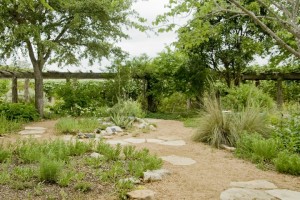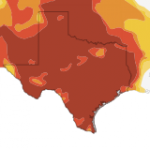Going ‘Native’ in Texas With Less Water

Photo by Jillian Schantz-Patrick/StateImpact Texas / StateImpact Texas
Janna George of Fertile Ground Organic Gardens takes the grass lawn out of a backyard where hardier native species will be planted.
Landscape worker Janna George sweats in the midday sun as she thrusts her shovel into the ground. She’s trying to get up all the grass in the backyard of a South Austin home. As anyone who’s dug into the Central Texas ground and come out with a rock-dented shovel knows, there’s little dirt to dig into. So for the needs of her job, she says, she has to salvage as much precious soil as possible.
Why save the dirt but take away the grass? It’s because the company she works for, Fertile Ground Organic Gardens, designs landscapes to be more compatible with the Texas climate. They follow an ethic of conservation, viewing grass lawns as a unnecessarily thirsty option for our semiarid climate.
Consider the findings of one Texas survey: about 2/3 of residents’ water use in the summer goes to watering their yards. Is the desire to have a nice yard in opposition to conserving our volatile water sources? For co-owner of Fertile Ground, Alexa Villalobos, achieving the two is not only possible; it’s ideal.
Villalobos describes what happens when Fertile Ground installs a new yard: “It’s fun to see what happens when you put the native plants…into your yard. Suddenly there’s butterflies, there’s hummingbirds, there’s bees, there’s lizards. There’s stuff to watch.”

Photo by Jillian Schantz-Patrick/StateImpact Texas
Alexa Villalobos (left) and Julie Donie (right) are the co-owners of Fertile Ground Organic Gardens.
Before they can create this type of environment, though, they must build up the soil that Central Texas lacks, as Janna George was attempting to do. The built-up soil, in turn, retains water much better, explains Villalobos. In that soil they plant shrubs, flowering annuals, and succulents mostly native to Texas that save water and thrive in dry, hot weather. Once established, these plants will be irrigated mostly by water falling from the sky.
But what if you would like a nice lawn in front of your house, where the kids can play and the dog can roam? A University of Texas ecologist explains that you can have your cake and eat it too… sort of.
Mark Simmons is the director of a landscape design firm based at the Ladybird Johnson Wildflower Center in Ausin. He thinks the grass lawn in Texas has been “demonized” by environmental critics, but he says that’s not necessarily the case. “We’re saying, ‘Well wait a minute, there’s nothing wrong with our lawns’. Even in the Southwest. We’ve just done them wrong,” Simmons says. “We’ve just created this landscape on life support when all we have to do is just design them ecologically.”
What does it mean to be designed ecologically? Think of a prairie on the Great Plains.
It has several species of grass mixed together. These species compete against each other. They take water when it’s available and go dormant when it’s not. They have adapted to their specific environment. Now shrink that down and put it around your house.
Presto! You have a lawn that needs less water. There’s now a competition between a variety of species, which inhibits weed growth. And the main fertilizer is what returns to the soil upon death. It’s a mini-ecosystem right outside your window.
But before native lawns can catch on in the public mindset, Simmons explains, certain mental adjustments must be made. First off, landowners would have to let their grass grow to four to six inches, a height proven by research to be more drought resistant. (The upside of this? You’d have to mow less often.)
The biggest mental hurdle to get over, though, is accepting a brown lawn during dry parts of the year. The hope is, he explains, that once people understand the ecology of their lawns they see brown not as a source of shame but a point of pride.

Photo by Jillian Schantz-Patrick/StateImpact Texas / StateImpact Texas
This is the Naturalistic Homeowner Inspiration Garden at the Ladybird Johnson Wildflower Center. According to their website, "The roughly 80 species used in this garden are almost entirely native to Travis County, Texas."
The period of time in which grass leaves go brown, known as dormancy, is an adaptation prairies have to get through dry periods. Are Texans ready to adapt to their environment? Alexa Villalobos thinks they are.
“The one aspect about the drought that was really exciting was the fact that I think it shocked people into recognizing that the way that we’ve been doing things is not sustainable,” she says. “And it’s been waking them up to the beauty and the resilience of the native plants.”
Apparently you can have your water and your nice yard too.



